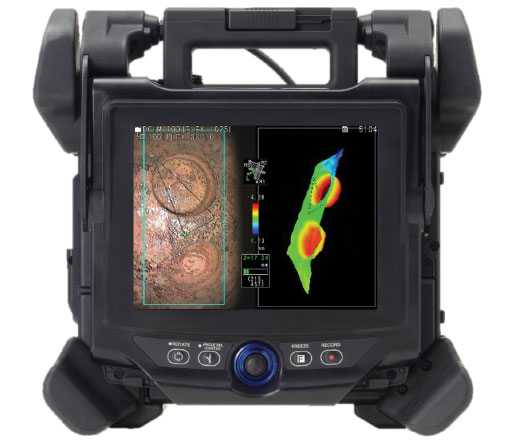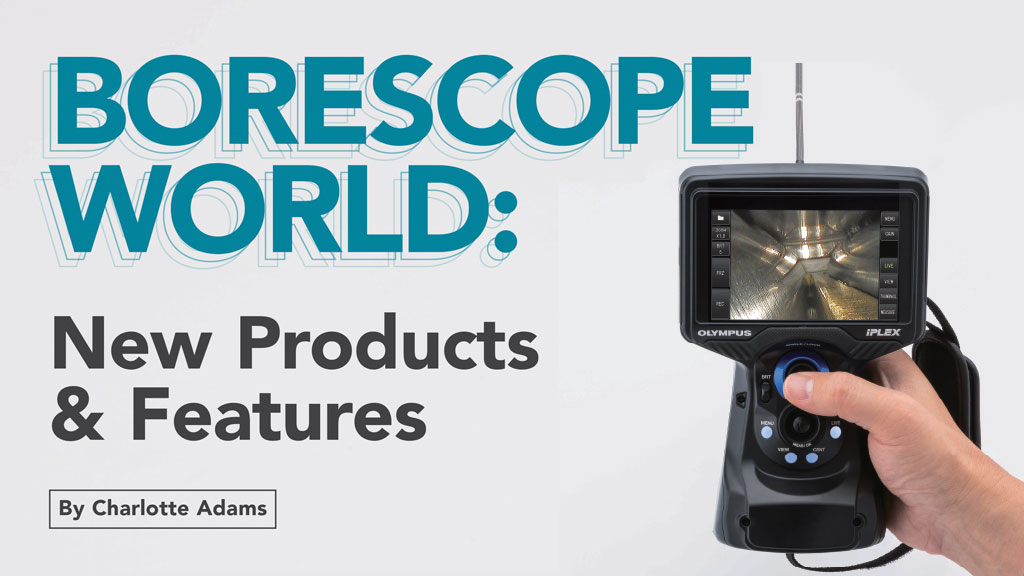Borescopes are at least as important to engine health as endoscopes are to human health – probably much more so. The aviation gear is used daily to visually check engine innards for cracks and other damage. The scopes shine a light on turbine blades and other components to assess their condition without having to take an engine apart.
Today’s high-definition, connected video borescopes are a far cry from rigid and fiber optic scopes. Who knows what the future holds?
Probably we will see more automation. “Imagine if the scope knew where it was going automatically,” asks Frank Lafleur, senior product manager for Olympus. With Big Data it may perhaps become possible to teach a scope how to go into an engine and identify the things it sees. We’re still many years away from having a scope do an inspection by itself, but there will be more and more inspection-assist features in coming years, he predicts.
Aviation borescopes come in all shapes and sizes, with a wide range of capabilities and price tags. At the high end are machines that can perform measurements to tiny dimensions with great accuracy and repeatability. Less pricey, mid-range scopes provide technicians most of what they need without overkill. Companies continue to add new products and features in this highly competitive market.
Video borescopes got to be dominant in aviation because of their high resolution and ability to show and capture images, says Doug Kindred, Gradient Lens president and chief scientist. You can do it with fiber optic scopes but it takes twice as long and you have to have a cart of equipment, including a separate camera and monitor.
Olympus
Olympus continues to evolve its top-of-the-line IPLEX NX, while adding a trio of products – the IPLEX GT, GX, and G Lite.
The GX, GT, and G Lite use scalar measurement as a standard feature, sizing objects in comparison to a reference defect, according to the company’s web site. All three products are optionally upgradable to stereo measurement, using precise 3D coordinates, the company says.
All three servo-driven video scopes also feature TrueFeel technology, ensuring that the borescope doesn’t lag or overshoot the target, Lafleur says. “What the thumb does is what the eye sees.”
All the scopes have the same accuracy – up to 1,000th of an inch – but the NX is the most precise, or repeatable, in its measurements, he says. The NX also has added 3D modeling as an enhancement to its measurement technology. This allows users to do things like set a reference line on a complex surface like a turbine blade. Users can then rotate the line to see what they’re inspecting from multiple angles, providing a sense of depth and making it easier to specify the exact location of measurement points, the company says. “It’s like moving from painting a portrait to sculpting a bust,” Lafleur says.
ViewTech
Right in the middle of the market is ViewTech Borescopes, formerly RF System Lab. ViewTech’s new VJ-3 borescope offers improved lighting, image quality, and ruggedness, as well as rechargeable batteries, says Duncan White, director of sales and marketing.
The company has achieved ruggedness ratings per the International Electrotechnical Commission (IEC) standard relating to IP (ingress protection), or the ability to handle moisture and resist dust and debris. This means you can use the base unit with the screen and joystick in the rain and that it also won’t allow dust inside, White says.
He says that ViewTech sells more borescopes in the U.S. and Canada, across a wide swath of industries, than anyone else. The company doesn’t say exactly how many scopes that entails, but more than 100 are out in the field on demo a year.
The 3.9mm-diameter insertion tube version of the VJ-3 is popular in aviation, White says. Four LEDs provide up to 6,000-lux illumination. And the VJ-3 has a 16-Gbyte SD card, which can store 10,000 photos or 8 hours of video, the company says. The 3.5-inch anti-glare LCD display monitor features 640×480 resolution. The company also moved from a stainless steel insertion tube to more durable tungsten braid. The 3.9mm probe comes in lengths of 1.5 and 3.0 meters.
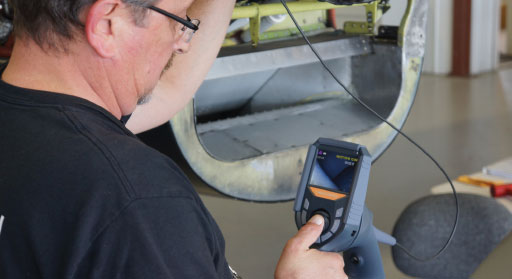
The price is also right, White says. The VJ-3 comes in at a range of $9,000 to $15,000, about the same spot as previous incarnations and “at or below anybody with a comparable borescope.” There is also a no-cost loaner program if a scope has been sent in for repairs.
Although commercial airlines require a borescope with measurement functionality, “we specifically left that off,” he says. But the high-end scopes with measurement capability don’t need to be used all the time, he says. Because ViewTech offers 80 percent or more of their functionality at a fraction of the cost, it makes sense to use the less expensive equipment as the workhorse for all the other things that need to be done to get more life out of the high-end equipment, he says.
ViewTech scopes are popular with general aviation engines such as the Pratt & Whitney PT6, White says. The equipment is also used to look at landing gear, avionics wiring, flap tracks, and radar domes, he says.
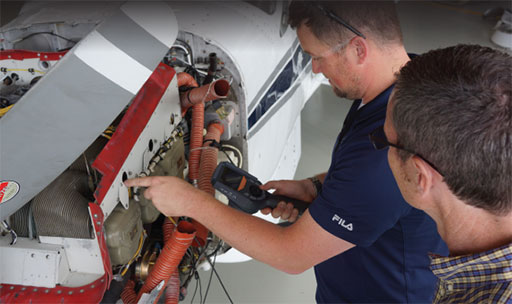
flap tracks and radomes. ViewTech image.
Mountain Air Cargo’s engine shop uses VJ-3s for everything from 1,500-hour, hot section “sneak and peek” inspections to condition inspections, says Chris Roop, engine shop lead. He uses it to look at PW100 engines in the carrier’s ATR fleet. Measurement capability would make the job easier but it’s not a necessity for everything, he says. “You scale everything out, use your noodle, and apply mathematics to it.”
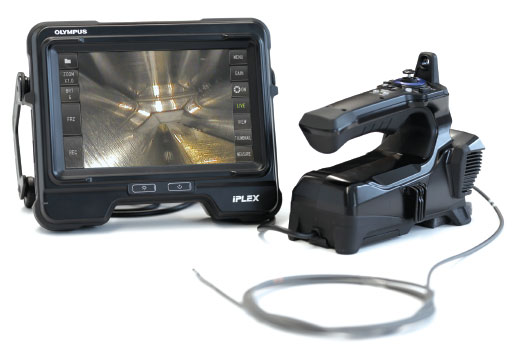
The VJ-3s are user-friendly, he says, with the light source built into one unit so you don’t have to have a heavy battery-pack light source hanging around your neck when you’re trying to climb a ladder. You position the optic where you want to look and it stays there, he adds.
The images an operator sees can also be viewed on a standard video monitor. Or the equipment can be connected to a laptop and show an inspection via Skype or GoToMeeting, White says. Roop shares photos with Pratt & Whitney via email so he can talk to the OEM about whether an engine can continue operating or should have a shop visit.
The VJ-3 is mechanically articulated – when the user moves the joystick, the scope responds. “It’s like a puppet on a string,” White says. Mechanical articulation has some advantages over servo-driven operation, he says. In addition to being lower-cost and less expensive to repair, the mechanical system provides tactile feedback. “Because your thumb is moving the borescope, you can feel resistance if you hit the side,” he explains.
High-end, servo-driven scopes can be a pain, Roop says. You have to be precise about where you’re trying to look because you can overshoot. You have to “pre-think” it and release the switch early. He likes the VJ-3’s mechanical articulation and its large angle of view. “That’s really nice to look around corners,” he says.
Gradient Lens
Gradient Lens plans to jump ahead in the middle market with the launch this summer of the company’s Hawkeye V3 video borescope, as a companion to the V2 equipment rolled out in 2012. “We’ve worked hard on fundamentals” like resolution, image quality, and illumination, Kindred says.
The 4mm-diameter scope will incorporate a high-definition, full-megapixel camera, Kindred explains, with six times the resolution of the current V2 product and three times the resolution of high-end competitors, he predicts. The 5.5-inch-diagonal display will be sunlight readable and the image quality will be comparable to what you get on an iPhone 7 or 8, he says. Illumination will be brighter, employing a 35-watt LED. The LED will be mounted inside of the base and the light transmitted to the tip via fiber optics.
The V3 will move from manual to servo-driven articulation. An advantage with servos is that you can go much further and maintain the range of articulation much better, Kindred says. It will also add Wi-Fi, so that a technician can be doing an inspection while his boss watches it on an iPad.
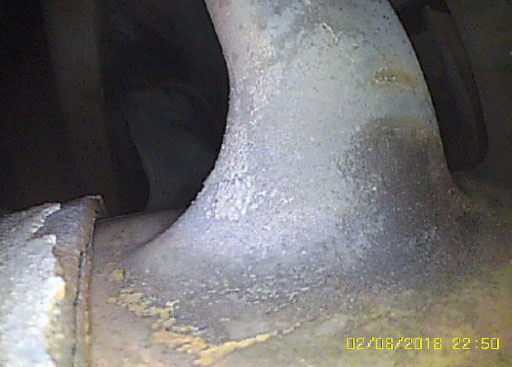
ViewTech images.
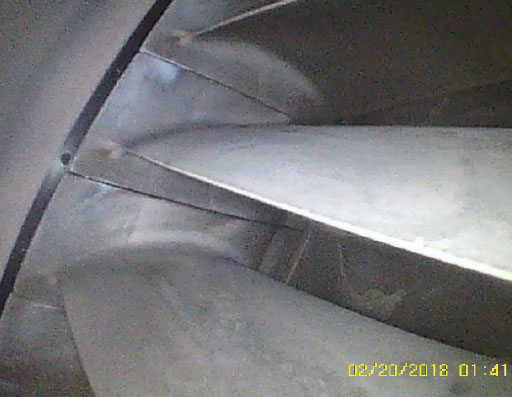
The V3 will be very competitively priced, he says, starting at around $10,000 vs. around $8,000 for the V2. “We don’t make a Rolls-Royce or a Mercedes. We make a product that’s extremely good quality” but that is not loaded with features like measurement.
Gradient borescopes are typically used in applications, such as inspecting turbine blades, combustion chambers, and fuel injection nozzles, to look for problems, such as cracks, he says. Some people, however, also use them to inspect areas of the airframe and wiring harnesses.
The company’s aviation focus is more on business and general aviation, including helicopters, for organizations such as police and sheriff departments.
The most important thing for aviation customers is image quality, he says. “What it really boils down to is you have to be able to tell whether something is a very small crack in a turbine blade or maybe a tiny piece of lint.”
Measurement
Some users have a requirement for measuring borescopes. You’ve got to have high image quality because you’re doing a visual inspection, but you’ve also got to have measuring capability, says Craig Grave, owner of AIM (Aircraft Inspection & Management), a maintenance facility that works on a wide range of engines, including Pratt & Whitney, Rolls-Royce, GE, and others.
If you find something in a borescope inspection, the manufacturer wants to know the size of the damage, he says. AIM uses a GE video borescope with 3D phase measuring. “It provides a 3D image on the screen that you can rotate around and see damage,” he says. The equipment is very pricey, however. By the time you get all the accessories and extra tips, it’s probably close to $70,000.
The unit itself is not overly complicated, but accomplishing an inspection takes skill – not everybody can do it, he says. You have to be able to manipulate the scope, get it into the right position, and get a good picture in order to do the measurement.
The other challenge is understanding what you’re looking at, he says. For example, is it a crack or a shadow? Sometimes an image looks like a crack, but when you get the scope into a better position you can see that that it’s something else, like a coating loss, Grave says.
Do’s and Don’ts
Pay attention to the operator specifications, Roop says. Use the right chemicals to clean the lenses because the wrong chemicals can damage or fog them. And never use a borescope inside a hot engine, he adds. He usually waits four hours in order to let the engine get below a certain temperature range.
And don’t drop it, White says. Warranties protect against manufacturing defects. They are not insurance policies against breaking the equipment. Also remember to steer the borescope out, he says. The borescope may have gone around some bends and turns during the inspection process. “You can’t just yank it out.”
“Don’t walk backwards” while guiding it out, he adds, and have your hand ready to catch the camera so that it doesn’t swing down and hit the deck. The cameras aren’t that fragile, he says, but if the quartz lens hits the floor from 4 to 5 feet up with any force, it won’t be too long before it shatters.
Another basic rule is to put the borescope back in the case when you’ve finished using it, White says. A common breakage scenario is when the scope is left on a table. Before long somebody comes along and sets a heavy part on top of it.
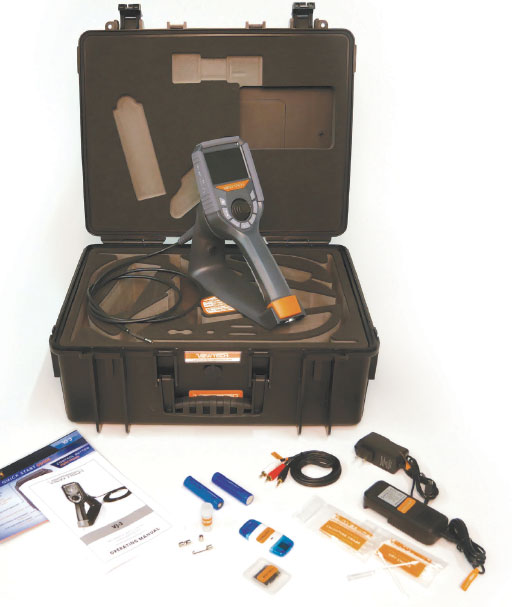
Also don’t put the scope back in the case with the tip hanging out, Kindred says. And don’t try to yank out the probe if the tip gets hooked around something. You have to straighten it out before you remove it. “It’s just a matter of being impatient and not thinking.”
Borescopes are fairly delicate pieces of equipment, AIM’s Grave says. The company has around 10 scopes because they tend to break fairly often, he says. One thing on his wish list is faster repairs.
